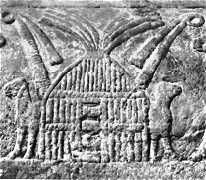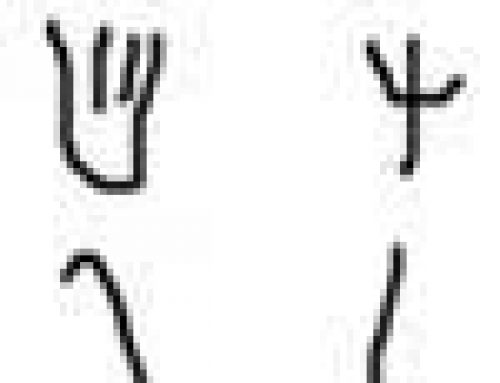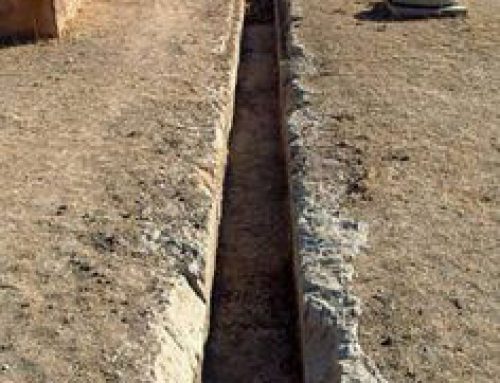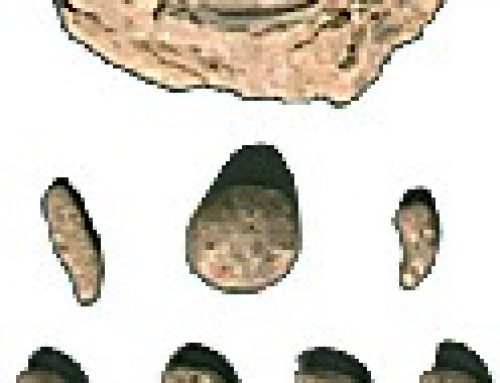
Sumerian architecture: the ziggurat at Warka (reconstructed by Saddam Hussein)
Mud-brick and brick
Like other people around the world, the Sumerians started to build big temples on artificial platforms around 3500 BC. They were living in the area between the Tigris and the Euphrates rivers. in what is now Iraq.
Because there’s practically no building stone in this area, but there’s lots of clay, Sumerian architects built their buildings out of mud-brick or fired brick.
(More about mud-brick)
This was so early that the architects didn’t know how to make a big building stay up if it was hollow inside, so the first big buildings are solid – like a sand-castle – rather than really useful as buildings. They’re more like artificial hills.
This is the same as the Egyptian pyramids, or the Valdivia and Norte Chico pyramids in Peru, which were built just a little later and are also pretty much solid inside.
(More about the Egyptian pyramids)
Sumerian ziggurats and town walls
Mostly what the Sumerians built was huge staircases of mud-brick which they called ziggurats. Each little city-state would build its own ziggurat, partly to please the gods and partly to show how powerful the town was. On top of each ziggurat, there was a small temple to Ishtar or Enlil or another Mesopotamian god.
The Sumerians also built town walls around their towns, also mainly out of mud-brick. These were also solid. (Fortification walls pretty much have to be solid!)
(More about ziggurats)

Sumerian architecture: King’s palace (Mari, ca. 1800 BC)
Sumerian palaces
The Sumerians in each city-state built palaces for their kings, too. They built the palaces were out of mud-brick too.
Not only the king but also his whole family and many slaves lived in these palaces.
But these palaces weren’t just to live in.They were the center of government, so a lot of the rooms were for courtrooms, meeting rooms, keeping government records in, and storing weapons for war.
Sumerian palaces were also storehouses for wheat and barley, beer and wine, and cloth. The warehouses held all kinds of things that the kings collected as taxes. And they held all kinds of things the king had gotten enslaved people to make in his factories to sell to other countries.
(More about the Sumerian economy)

Sumerian reed hut
Patterns of light and dark
Mud-brick buildings like these would look pretty boring if they just had straight walls, all brown. So the builders made the buildings look more interesting by creating areas of dark and light on their walls. The walls of Sumerian temples and palaces went in and out at regular intervals, making a sort of pattern of shadows.
Sumerian houses – reed huts
Ordinary people didn’t live in palaces, though – they lived in simple reed huts like this one. They sat and slept on the ground, on woven reed mats, or on mud-brick platforms with woven reed mats on them. They cooked over a firepit or a brazier in the middle of their hut, or in a mud-brick oven in the courtyard outside their house.
(More about braziers)
Sumerian houses – mud-brick apartment buildings

A model of a house (Egypt, ca. 1500 BC)
Other Sumerians lived in mud-brick apartment houses built inside a courtyard. We don’t have any models of them from Sumeria, but this is an example from ancient Egypt.
Usually each family had one room. All of the families did their cooking and washing in the courtyard together. Sometimes people kept donkeys or sheep in one of the rooms, too. Or one of the rooms might be a store-room for equipment.
(More about Egyptian houses)
Did you find out what you wanted to know about Sumerian architecture? Still have questions? Let us know in the comments!





thanks this helped me for my project
I’m happy to hear it, Blake! If your teacher or your school has a website with homework links, we’d be delighted to be added to it so more students and teachers could find us!
I recently saw a video, on one of the Science web sites, where a 100 pound iron anvil was floated in a basin of mercury! The anvil appeared to be weightless! The question I have is did the anvil increase the weight of the basin of mercury?
Also has anyone tried to see if Granite or limestone floats on mercury?
Remember the tanks of mercury found at Puma Poncho??
Yes, if you put an anvil in a basin of mercury and weigh the whole thing, on Earth it will weigh more than the same basin without the anvil. Anvils can’t really be weightless. The explanation is that mercury is still very thick even when it is liquid: it doesn’t behave like water, even though we expect most liquids to behave a lot like water.
Yes, granite would float on mercury.
Please whats the source of materials used..as in where and where are they gotten from? ..and what are the list of materials used?
That would be a whole other article! Mostly they are using brick, which is just clay dug up from the riverbed mixed with straw. You can find out more about straw here: https://quatr.us/economy/straw-history-straw.htm
It helped me very much for my project
Wonderful! Thanks for taking the time to let us know, and I hope your project comes out great!
Sir.. Will these points will associate with the evolution of ziggurat.??.. .. If not can u plz tell me about that?? Evolution of ziggurat
The article doesn’t really explain the evolution of the ziggurat. Ziggurats started out as temples built on the ground. Rulers started to make the temple seem bigger and more important by building an earth mound – an artificial hill – and building the temple on top of that. Later rulers made even bigger mounds, with smaller mounds on top of them, so they would be more impressive. I think that must be what you mean by the evolution of the ziggurat? Of course they are not alive so they can’t really evolve.
Sir… U helped me for the exam thank u…
Happy to hear it! Best of luck on your exam!
Do you know what what invention added strength and beauty to summerian architecture???
I think the question probably refers to this paragraph of the article: “Mud-brick buildings like these would look pretty boring if they just had straight walls, all brown. So the builders made them look more interesting by creating areas of dark and light on their walls – the walls went in and out at regular intervals, making a sort of pattern of shadows.”
I really enjoyed this website and found it very helpful
Wow, that’s great! Thanks for taking the time to let us know.